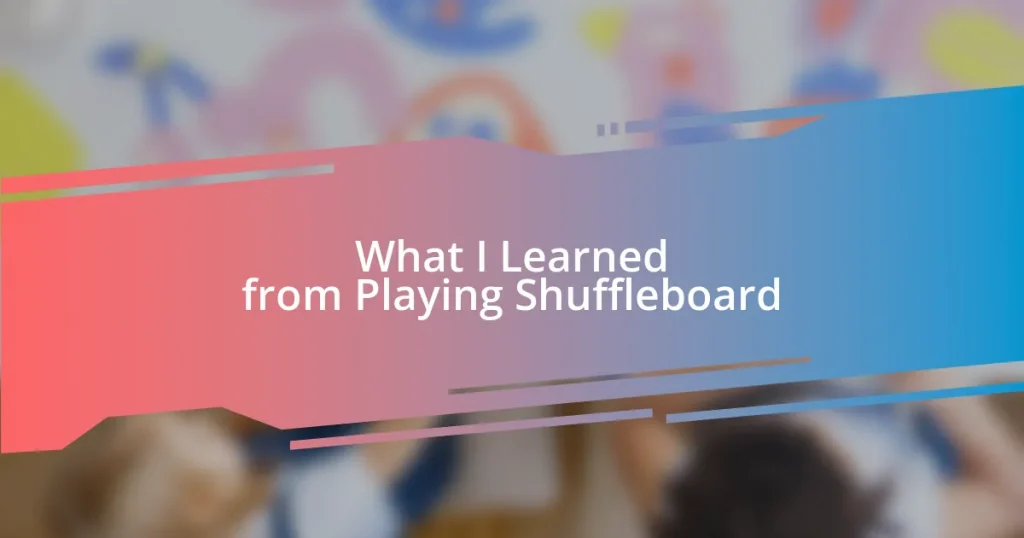Key takeaways:
- Shuffleboard combines skill and strategy, requiring players to focus on both offense and defense while anticipating opponents’ moves.
- Essential equipment, including a shuffleboard table, pucks, cue sticks, and a scoreboard, significantly influences gameplay and enjoyment.
- Regular practice and refining techniques such as stance, speed control, and strategic play are crucial for improving performance.
- Playing shuffleboard fosters social connections and offers mental relaxation, making it a rewarding experience beyond competition.

Understanding the Basics of Shuffleboard
Shuffleboard is a game that combines skill and strategy. I remember the first time I stepped onto a shuffleboard court; the smooth, polished surface and the clattering of pucks were both inviting and intimidating. I felt a rush of excitement as I tried to understand the basic rules—getting my puck into the scoring zones while trying to knock my opponent’s discs off.
One key aspect of shuffleboard is its scoring system, which can seem a bit complex at first. Each player takes turns sliding their pucks down the court, aiming for different sections marked with varying point values. As I learned to aim for the highest points while keeping my eye on the opponent’s pucks, I began to appreciate how strategy evolves with every shot. Have you ever thought about how a simple game can teach you so much about planning and foresight?
The equipment itself is pretty straightforward. Just a slick puck and a long cue are all you need to begin. Initially, I found it challenging to gauge the right amount of force needed to slide my puck effectively, but with practice, it felt like an extension of my arm. This physical connection to the game truly enhances the experience, turning every session into both a mental and physical workout.

The Essential Equipment for Shuffleboard
The beauty of shuffleboard lies in its simplicity when it comes to equipment. As I delved deeper into the game, I appreciated how each element plays a vital role in enhancing the experience. From the weight of the pucks to the grip of the cue, everything matters. I remember the first time I used a well-balanced cue; the way it glided in my hand made each shot feel more deliberate, almost like an artist with a brush.
Here’s a quick look at the essentials you’ll need for shuffleboard:
- Shuffleboard Table: A smooth, polished playing surface typically 22 feet long for indoor play.
- Pucks: Also known as discs, these come in various weights and colors. The feel of a well-crafted puck can influence your game significantly.
- Cue Sticks: Used to slide the pucks; length and grip can vary, impacting your precision and comfort.
- Scoreboard: While not mandatory, it helps keep track of scores, making the game more competitive and engaging.
- Cleaner: Maintenance is key! A good cleaner keeps your table slick and fast, affecting puck movement.
Having the right equipment not only affects gameplay but also enhances the fun. I still recall a day when we had just the right pucks and cues, leading to a friendly rivalry that had us laughing and strategizing for hours. It’s moments like these that make shuffleboard more than just a game; it turns into a social adventure.

Techniques to Improve Your Game
Improving your shuffleboard game is all about sharpening your techniques and honing your precision. One method that worked for me was practicing my stance. I found that a solid base helps maintain balance and control. When I focused on positioning my feet shoulder-width apart and slightly bending my knees, it really transformed my shots. Have you ever experimented with your stance to see how it affects your aim? You’ll be surprised at the difference it makes!
Another key technique I adopted is understanding the importance of speed. Learning how to judge the speed of the table was a game-changer for me. Each surface is different, and I remember struggling with a particularly fast table during a local tournament. By practicing in various conditions, I learned to adjust my force based on the table’s characteristics. It’s all about adapting and observing, which ultimately leads to a more enjoyable game.
Lastly, don’t underestimate the value of strategy in shuffleboard. I recall one match where I focused on placing my pucks defensively while maintaining a strong offensive stance. This dual approach allowed me to protect my scoring area while still aiming for high-value zones. It was a reminder that shuffleboard isn’t just about throwing pucks; it’s about reading the game and anticipating your opponent’s moves. How often do you think about your opponent’s strategy while playing?
| Technique | Description |
|---|---|
| Stance | Maintain balance with feet shoulder-width apart and knees slightly bent to improve shot precision. |
| Speed Control | Learn to adjust your force based on the table’s speed for better puck placement. |
| Strategic Play | Combine offensive and defensive tactics to control the board and anticipate opponents’ moves. |

Strategies for Successful Play
When it comes to shuffleboard, one strategy that really reshaped my play was focusing on angles. I vividly remember a game where I decided to target the corners instead of going straight for the middle. That decision led to some surprising victories, as my opponents often underestimated the power of a well-placed shot that caught them off guard. Have you ever noticed how a slight angle can completely change the dynamics of a play?
Additionally, I learned the significance of taking calculated risks. There was a moment during a heated match when I was tempted to go for a high-scoring zone with a risky shot. I hesitated at first, but then decided to trust my instincts. I took the shot, and to my delight, it not only scored big but also put immense pressure on my opponent. I encourage you to occasionally step out of your comfort zone; who knows, it might just lead you to that thrilling win!
Beyond just physical strategies, I found that maintaining a calm mindset is crucial. In one of my most intense games, emotions ran high as the score remained close. I took a moment to breathe and reflect, reminding myself that it’s all in good fun. This approach not only eased my nerves but improved my performance significantly. What strategies do you use to keep your cool under pressure? Embracing a relaxed attitude can truly enhance your game and allow you to enjoy each moment on the table.

Common Mistakes in Shuffleboard
There are a few common mistakes I’ve noticed that can really hinder your shuffleboard game. One major error is underestimating the importance of practice. I remember stepping into a game without having placed a puck in weeks. I quickly realized that my shots were all over the place! Regular practice not only improves accuracy, but it also builds muscle memory. Have you experienced that “getting back into the swing of things” feeling? It’s a reminder of how consistent practice can elevate your game.
Another mistake I often see is overthinking the angles. During one of my matches, I fixated on trying to calculate the perfect angle for my shot while the game moved on around me. Instead of just letting instinct take over, I missed a few crucial opportunities. Now, I try to balance strategy with a bit of instinct, allowing myself to intuitively gauge the shot rather than getting stuck in my head. Have you ever let hesitation cost you a point? Sometimes, it’s about trusting yourself more than over-analyzing.
Lastly, people often mistake shuffleboard as a solo sport, forgetting the importance of reading their opponents. I recall playing against someone who was strategically placing their shots while I was simply trying to score high. I was so focused on my own game that I didn’t notice their defensive tactics. By stepping back and considering my opponent’s moves, I could have adjusted my strategy effectively. Have you thought about how your positioning can impact your opponent’s decisions? It’s a dynamic dance in shuffleboard that adds another layer of strategy to the game.

Benefits of Playing Shuffleboard
Playing shuffleboard has brought me a wealth of benefits beyond just the thrill of competition. For starters, it’s a fantastic way to improve my hand-eye coordination. I remember a specific game where, after a few rounds, I could see a significant improvement in my accuracy. Targeting my shots became more instinctive rather than a struggle, and that sense of progress feels incredibly rewarding. Have you ever experienced that satisfying moment when the effort really pays off?
Another hidden gem of playing shuffleboard is the opportunity for social interaction. Every time I gather with friends for a match, it feels like an event. The laughter, banter, and occasional friendly rivalry create an atmosphere that simply can’t be replicated. I often find myself reminiscing about those weekends where we formed teams and engaged in light-hearted competitions. It’s not only about winning; it’s about the connections we make and the memories we create. Don’t you think shared experiences make games like shuffleboard even more enjoyable?
Moreover, shuffleboard has also offered me a refreshing mental break. Often, after a long day filled with stress, playing a few rounds allows me to unwind. I recall once feeling completely overwhelmed before a casual evening game with friends. As soon as I picked up that puck, my worries began to fade. Focusing on my strategy and the fun of the moment provided a much-needed escape. Have you discovered how a simple game can lift your spirits and clear your mind? It’s amazing how a bit of playful competition can refresh your outlook and boost your mood.

Reflections on Personal Growth
Reflecting on my journey with shuffleboard has revealed how intertwined personal growth and play can be. I recall one evening where a series of losses left me frustrated. Instead of sulking, I chose to analyze why I struggled and how I could improve. This shift in perspective taught me that embracing failure isn’t the end; rather, it’s a pathway to self-discovery and growth. Has a setback ever taught you more than a victory?
As I honed my skills, I noticed a new sense of confidence emerging within me. Each successful shot became a small victory that boosted my self-esteem. I often find myself remembering those moments when perseverance paid off. They remind me that growth isn’t always a straight path; sometimes, it’s about the small victories that build resilience. How do you celebrate your own progress, even those tiny wins?
Over time, playing shuffleboard with friends opened a window to better communication and collaboration. I found myself not just playing the game, but also learning to listen and adapt to others’ styles. One particular match stands out, where a teammate and I had to quickly change our strategy mid-game. That experience not only improved our synergy on the board but also strengthened our friendship. Are you nurturing your relationships through shared activities or challenges? Each game teaches us something not just about the sport, but about each other too.















